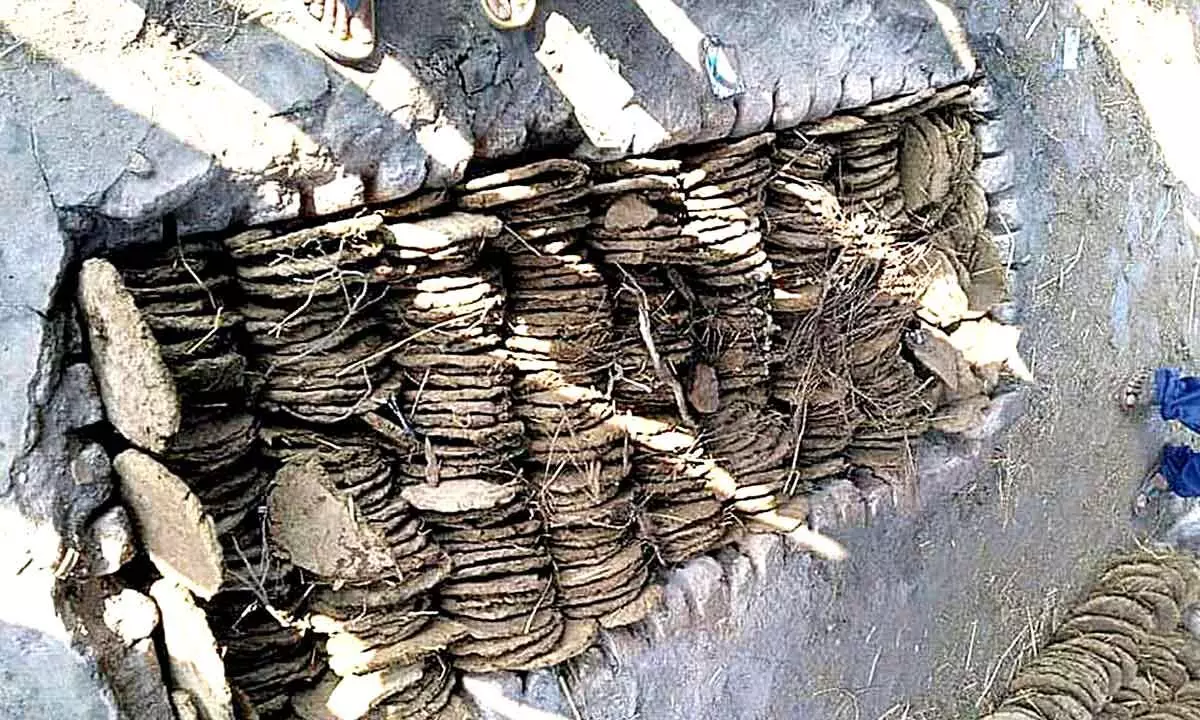Live
- Completely disagree: Swami Rambhadracharya on Mohan Bhagwat's 'Hindu leaders' remarks
- ISL 2024-25: NorthEast United aim to regain form against struggling Hyderabad
- CII seeks priority sector lending for new and emerging sectors
- Russia's missing An-2 plane found, all aboard alive
- GST recommendations to create business-friendly environment, ensure fairness: Experts
- Army pays tribute to first informant of 1999 Kargil intrusion Tashi Namgyal
- Earnings forecasts of Samsung, SK hynix for Q4 downgraded
- Jaipur crash horror: The U-turn that should never have been there
- FairPoint: The ‘push’ complaint politics may hurt Rahul Gandhi more
- Sr National Badminton: Defending champ Anmol Kharb, Ayush Shetty bow out in pre-quarters
Just In
Paralakhemundi uses cow dung cakes for cremation


Cow dung cakes for cremation at Puri Swargadwar
Berhampur: When Odisha government is mulling over use of cow dung cakes instead of firewood for cremation at ‘Swargadwara’ in Puri, not many perhaps know that this eco-friendly method has been adopted in Paralakhemundi for the last eight decades.
No firewood and electric heaters are used in any of the four crematoriums -- on the banks of Mahendratanaya river, Gopalpur, on the outskirts of Odisha-Andhra border, Hatibadi in Padmanav Tota and another near Sita Sagar -- in Paralakhemundi.
About 1,200 pieces of cow dung cakes (ghasi) which cost Rs 4,200 are required to burn one body in six hours. Transportation charges of these cow dung cakes from the outlet to the crematorium by bullock cart and trolley rickshaw costs Rs 500 to Rs 600. The cow dung cakes used for this purpose are prepared by female members of ‘Gola’ and ‘Kampa’ communities. These are uniform in size with six-inch radius and about 1.5-inch width, said Bira Kishore Patnaik (63), a social activist of Karana Street.
Though cremation by cow dung cakes requires a special technique, almost all the residents know the skill and the locals help out the outsiders. One must dig 5-foot long, 2-foot wide and 2-foot deep hole in the crematorium. Five hundred cow dung cakes in 10 lines (50X10) in two layers must be packed in the pit to allow air into it. One has to ignite the remaining cow dung cakes separately. When the dead body is kept over the cow dung cakes and funeral pyre (Mukhagni) is lit, others pour the burning cow dung over the dead body and it catches fire with the help of kerosene. The burnt cow dung cakes remain hot for up to 18 hours. ‘Hadasitala’ of the body is generally carried out the next morning by pouring water on it.
Though about 150-kg of firewood is required to burn a dead body, nobody burns bodies with firewood as it is not available in Paralakhemundi. Locals prefer cow dung cakes and they don’t mind the cost factor.
When Maharaja Krushna Chandra Gajapati of Paralakhemundi (who ruled the estate from 1913 to 1947) opened a ‘Home Farm,’ which was an experimental project for dairy farming on a large scale, it produced huge quantity of cow dung everyday besides milk. The Maharaja’s appeal to go for the cremation of dead bodies by using cow dung cakes instead of firewood as an eco-friendly method prompted many to follow the new concept. The use of cow dung cakes in funerals became a practice as it not only solved the problem of garbage and sanitation, but also saved firewood thereby the green cover, sources said.
The Maharaja was a great animal lover and the then Member of ‘Royal Commission on Agriculture’ also invited famous veterinarian and author of the famous book ‘Indian Breeds of Cattle’ R L Kaura from London to his ‘Gajapati Palace’ to suggest improvement of his private ‘Home Farm’. Kaura stayed in the Gajapati Palace for a few years.
Uttar Pradesh, Gujarat, Madhya Pradesh, Rajasthan, Delhi and Bihar are already using dung logs and pellets to cremate bodies. Pune Municipal Corporation (PMC) started using cow dung cakes at its 26 crematoriums across the city in February this year which attracted the attention of Prime Minister Narendra Modi. In 2023, Uttar Pradesh Chief Minister Yogi Adityanath had directed officials to ensure that 50 per cent of the total fuel wood used in funeral fires at crematoriums in the State comprised ‘Upala’ (cow dung cakes) sourced from stray cow protection centres. In Mathura-Vrindavan region of Uttar Pradeh, bodies have been cremated using cow dung-based bio-fuel for the past four years.
The use of cow dung cakes for cremation aligns with Hindu religious practices. Hindu Dharma has framed various religious ‘samskârs’. Among them, the post-death rite is the final samskâr. This final samskar is known as ‘Antyeshti Samskara’, final reincarnation and the cremation ground is called Shmashana (in Sanskrit) and traditionally it is located near a river, if not on the river bank itself. This is a new and positive viewpoint on the use of a novel and environment-friendly method of cremating bodies by using cow dung cakes.

© 2024 Hyderabad Media House Limited/The Hans India. All rights reserved. Powered by hocalwire.com






